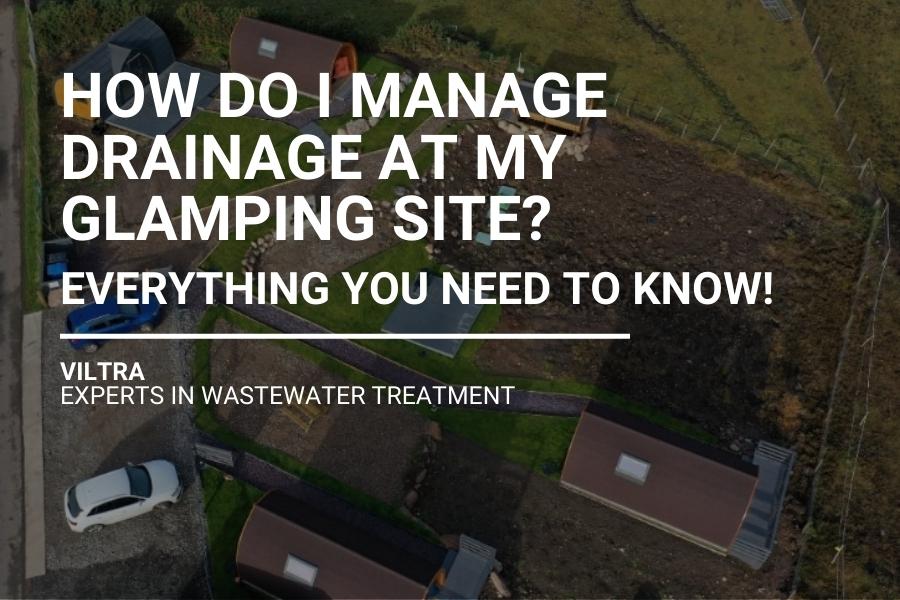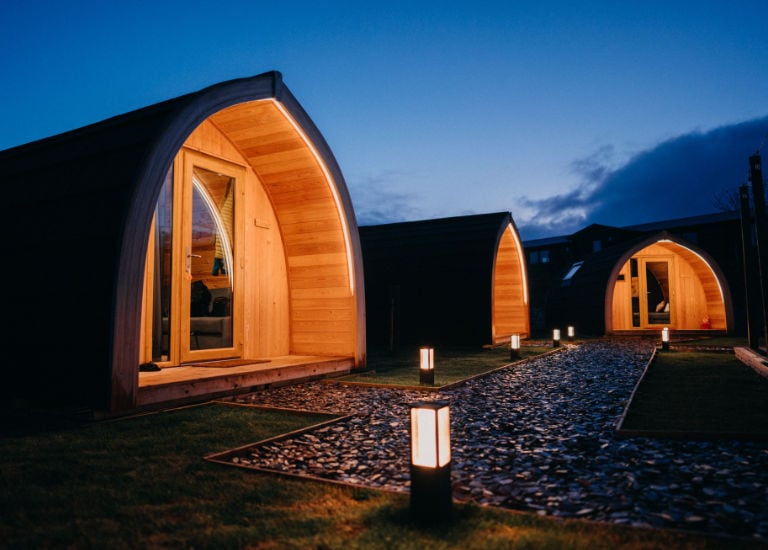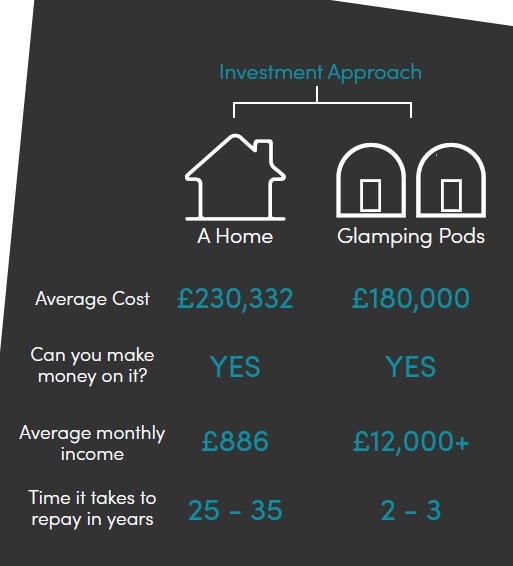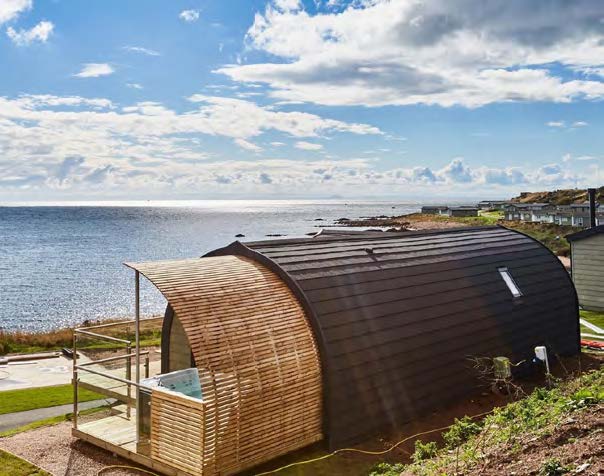How Do I Manage Drainage at My Glamping Site? What You Need to Know
Created by Calum Published on

When setting-up a glamping site, the first thing that springs to mind is your site being open, being full and the guests streaming in. Maybe a less exciting fundamental, often being considered fully towards an impending “opening day”, is how you are going to deal with the waste-water (or sewage) generated by guests during their stay on your site.
So, let’s talk about foul drainage, wastewater treatment and all the less glamorous sides of glamping.
DOWNLOAD YOUR FREE GUIDE TO STARTING A GLAMPING BUSINESS NOW
What Types of Foul Drainage Can You Use at a Glamping Site
- Septic Tank
- Sewage Treatment Plant
- Collection Tank or Cesspool
- Composting Toilet
- Constructed Wetlands

What is Wastewater Treatment?
Near any process that uses water, showering, bathing, WCs, cooking, dish-washing, produces a waste stream that needs treated and disposed of properly.
A failure to do this properly can lead to environmental harm and has the potential to ruin your guests’ experience at your site. That’s why it is vital to put the right system in place and to do that the right steps need to be followed.
There may be a choice of solution but each will require its own set of steps to ensure the authorities are satisfied and that the system will work.
Having a properly designed and installed treatment system in place will ensure that you have removed the potentially polluting elements from the waste-water and can return treated effluent to the environment in a manner both safe to the environment and the guests.
This last point is important as a poorly designed system might have no detrimental effect on the local environment yet lead to odour nuisance and/or effluent ponding – a public health risk.
Why do You Need Foul Drainage at a Glamping Site?
Foul drainage refers to the pipework system and its contents from WCs, bathrooms, en-suites and kitchens, etc. Similar to households, a glamping site will have most, if not all, of the following facilities:
- Toilets
- Sinks
- Showers and Baths
- Dishwashers
- Washing Machines and Dryers
Waste from washing and dishwashing is often referred to as greywater and that from toilets as blackwater but unless separated the combined flow is considered ‘foul’ because it is contaminated with pollutants, such as human waste and potentially harmful detergents, grease, and chemicals.
In most cities, towns and villages wastewater is directed to the main water authority sewer network which, in turn, connects to a waste-water treatment works. For a glamping site, or any “off-sewer” situation, the general principle is the same but the potential final treatment solutions tend to be more diverse. In most cases, however, following treatment, the residual effluent is discharged directly to a waterbody (river, coastal waters, stream) or, indirectly to groundwater, via a field drainage system.
Book a free consultation with one of our in-house experts.

What are the Different Options for Glamping Wastewater Treatment?
There is a multitude of diverse options for waste-water treatment but here we will focus on those most prevalent across Europe.
Composting toilet
There are various set-ups but in general this type of toilet consists of a well-ventilated container below a WC that stores and composts waste. Unlike conventional toilet systems, there is no flushing involved thus their use can help reduce water consumption.
Compost toilets depend on aerobic processes (delivered by worms, beetles, ants, bacteria, fungi and other micro-organisms) being able to break down waste and convert it to a notably more benign substance or even “product” that may fertilise ornamental, non-food crop, plants and shrubs.
Experience has shown that compost toilets work best when urine and other liquid is diverted away from the compost, to avoid the creation of a putrid sludge. In many glamping situations, therefore, composting toilets do not negate the need for a complimentary soakaway/ drainage field, to deal with the urine and greywater from hand-washing (unless a hand-gel is used), and, in addition, a system to deal with greywater from showers, baths, dishwashing etc.
That being the case, if the land is capable of supporting a drainage field, it can be more cost effective to simply install a septic tank or treatment plant (depending on ground conditions) ahead of a drainage field and divert all waste-water by the same route – that’ll need done for the greywater anyway (although, in Scotland, the updated guidance to the Scottish Building Regulations do appear to allow greywater to go directly to a drainage field, with no pre-treatment).
Compost toilets tend, therefore, to be either a “lifestyle choice” or deployed in situations where glamping units are not equipped with any washing or cooking facilities, these being available at a central hub.
DOWNLOAD YOUR FREE GUIDE TO STARTING A GLAMPING BUSINESS NOW
Collection Tank or Cesspool
A fully sealed, no-discharge, collection tank is commonly known as a cesspool. It is simply a holding tank in which waste-water collects.
When the tank is full, the waste is tankered away by a licensed waste contractor incurring an emptying charge.
As the rate of tank filling and the cost of tank emptying are significant, a cesspool is often the “last resort” and is, indeed, not a legal option in Scotland.
Septic Tanks
A septic tank is typically a one or two -chambered tank that separates gross solids and some suspended solids from waste-water and in doing so removes part of the potentially polluting load.
Within the sludge, anaerobic (septic) biological processes can help decompose and consolidate the sludge but not only are these processes slow, modern day waste-water is significantly different ion both volume and composition to that of 100 years ago.
As a result, many septic tanks do simply operate as little more than settling tanks thus careful consideration must be given to how and where the “strong” residual effluent is discharged.
In most of parts of the UK and Ireland, but not all depending on dilution available, septic tank is potentially so polluting that it cannot be directed to a watercourse.
Like collection tanks, septic tanks also require desludging, typically once per year and, while simple in their operation, should, as per all treatment systems, be monitored and maintained regularly.
Book a free consultation with one of our in-house experts.

Sewage treatment plants (secondary/ biological treatment)
A sewage treatment plant provides more effective treatment of waste-water than a septic tank. With the proper, site specific, standard of treatment, the effluent from a treatment plant can be discharged to a slightly smaller drainage field and, in many cases, a watercourse where the ground has insufficient infiltration potential.
There is a wealth of different treatment set-ups but near all have in common the encouragement of aerobic biological processes to undertake the treatment of the incoming “feed/food”.
In simple terms, all try to ensure the waste-water is brought into contact with oxygen and a population of organisms and micro-organisms that depend on the two.
Historically, the common means of doing this was to trickle settled waste-water over a biological filter within which a diverse population of organisms would live and thrive on the waste-water and some modern-day package plants replicate this process.
Other systems are based on the activated sludge process, discovered in 1913 and deployed at many municipal works thereafter, where instead of a “fixed-film”, the waste-water and the organisms undertaking the work are in an agitated, aerated admixture. And then there are hybrids of the two. Whatever the configuration, regular monitoring and maintenance (including desludging) are essential for long-term functioning.
Most systems, though not all, require the input of power to introduce air (oxygen) into the process and while that might be considered a disadvantage, annual consumption rates are relatively modest and might be evaluated in comparison to the annual costs if connected to a water authority sewer.
Careful design consideration must be given to the long periods of inoccupancy that most leisure sites, including glamping sites, can be subject to seasonally. With no waste-water feed, the populations of organisms undertaking the treatment processes can die-off and, thus, need positive intervention to ensure re-establishment for the start of the next season.
DOWNLOAD YOUR FREE GUIDE TO STARTING A GLAMPING BUSINESS NOW
Constructed Wetlands
Constructed wetlands are treatment systems based around reeds, other water-loving plants, open water, or hybrids of these, that rely on natural processes to undertake the required waste-water treatment although, many of the processes and the organisms delivering them, are the same as those in the aerobic and anaerobic systems above.
Most reedbed treatment systems (RBTS) have a gravel substrate in which filtration takes place. In general, land-take is greater but their “open” nature allows for the positive effects of sunlight (notably the effects of UV), evaporation and evapotranspiration. There is also incident rainfall and, therefore, a dilution effect to consider.
On sloping sites, they can be entirely passive, requiring no electrical supply, whereas on flat sites pumping is likely to be required. Where the land is available, they can offer a good, “complimentary” option to your glamping site.
Conclusion
There are many ways to manage the drainage at your glamping site. Some more appealing than others.
Composting toilets are ideal if you are looking for an off-grid or cheaper solution that requires some more management.
If you are looking to create a high quality glamping site you are likely to lean towards a treatment plant or soakaway.
Whatever option you go for, Viltra and Glampitect can help.
What Now?
Book a free consultation with one of our in-house experts. Once you've told us about your glamping plans, we'll guide you through the process of starting your glamping business, one step at a time.
Download your free Start a Glamping Business Guide Now: